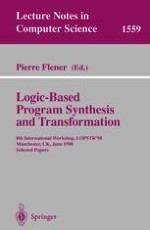This book presents the thoroughly refereed post-workshop proceedings of the 8th International Workshop on Logic-Based Program Synthesis and Transformation, LOPSTR'98 held in Manchester, UK in June 1998. The 16 revised full papers presented were carefully reviewed and selected during three rounds of inspection from a total of initially 36 extended abstracts submitted. Also included are eight short papers. Among the topics covered are logic specification, mathematical program construction, logic programming, computational logics, inductive program synthesis, constraint logic programs, and mathematical foundations.
